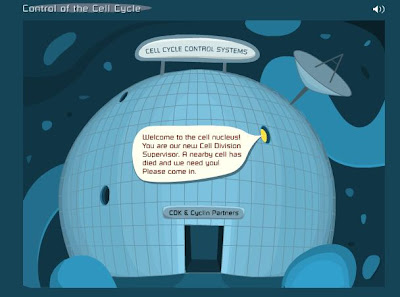Hi it's Catie! I'm the scribe of the day today! WOOOO!
Alright, so today in class, the first thing we did was turned in our cancer papers. I hope we all did well! After that, we discussed the lab we did yesturday. Turns out, MR PAEK was the instigator of the disease. ED was the one and only carrier of the disease. Silly old Ed!
After this, we discused VIRUSES. Viruses are interesting little creatures. Well, actually, they aren't creatures at all; they are NONLIVING, because they do not have all of the traits that scientist say make a thing living (CELLS are the smallest unit of life, not viruses!).
A protein coat, called a CAPSID, surrounds a virus. Viruses are sneaky little things. A virus uses its proteins to 'trick' a cell to take in the virus/its genetic material. (Speaking of which, a virus's genetic material consists of DNA/RNA.).
A virus can ONLY reproduce within a host cell; it can NOT divide on its own. Viruses are PARASITES, because they exist off of an organism and harm the organism while doing so. There are two cycles of a virus entering a host called the Lysogenic Cycle and the Lytic cycle. In the lysogenic cycle, the virus enters a cell and the viral DNA integrates into the host's DNA. Then, the host cell replicates WITH the viral DNA. From there, more and more virus cells get created! The lytic cycle is very similar, except for an important part. In the lytic cycle, the cell EXPLODES!!!!!!!!!!!!!! and the viruses are let out and spread quite rapidly to other cells.
In other words: Cell go boom = Virus get spread.
After discussing viruses, we were going to watch a video. But 8th period jitters got the best of us again, so we didn't get to watch the video yet. :( But don't worry folks, we will watch it next time!
BIOLOGY RULES!!!!!!!!!!!!!
Ok bye!
Next scribe is.. Maggie :)
 During the start of class we turned in our quiz corrections from over the weekend if necessary. Then Mrs. Stein gave us another DOD (disease of the day), which happened to be Malaria. The agent of disease was protozoan (protist). -------------------->
During the start of class we turned in our quiz corrections from over the weekend if necessary. Then Mrs. Stein gave us another DOD (disease of the day), which happened to be Malaria. The agent of disease was protozoan (protist). -------------------->



 (thisss is gonna be the best one yet nbd)
(thisss is gonna be the best one yet nbd)












